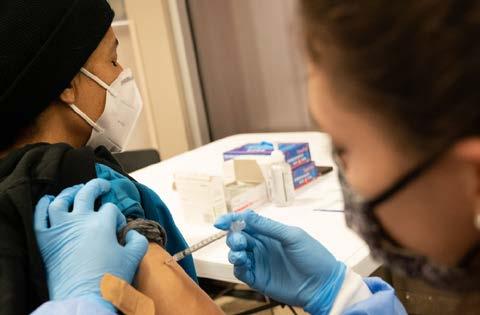
5 minute read
FIRST READ
EDITOR’S NOTE

Advertisement
RALPH R. ORTEGA
Interim editor-in-chief
Brooklynite Charles Schumer is one of the most poweful Democrats in the country – and in New York City. THIS WEEK’S ISSUE offers a comprehensive look at the most powerful people in New York City, and it couldn’t come at a better time.
Local and state governments are battling to recover from COVID-19, which has claimed about 20,000 lives in New York City alone. There is also the city’s budget crisis, which must be addressed without delay and with financial support from the federal government.
City & State’s latest New York City Power 100, our annual list of the city’s most politically influential people, includes those working on the solutions that will help the five boroughs recover from the pandemic.
Also in this issue are analyses written by Jeff Coltin on New York City’s mayoral and comptroller races, both of which will decide who fills these key government positions in a post-pandemic future. His mayoral piece includes a roundup of the 10 top candidates out of at least 38 who have filed to run. While the comptroller race may not seem as sexy, Coltin points out that “if you want to set yourself up to run for mayor, you’ve got to win this race first.” The comptroller race has 10 candidates so far, including six who seem to be serious contenders.
These elements have come together to make this issue a must-have resource on the city’s power players, who will be working hard on its recovery as we look to better times ahead.
CONTENTS
FIRST READ … 4
The week that was
NEW YORK CITY POWER 100 … 8 This is it. The big one.
THE MAYORAL RACE … 26
The candidates already wield a ton of power.
THE COMPTROLLER RACE … 46
A stepping stone to City Hall
IMMIGRATION COALITION … 56
Advocates embrace a postTrump world
WINNERS & LOSERS … 66
Who was up and who was down last week


Bronx residents receive COVID-19 shots at a new state vaccination site at Yankee Stadium.
RACIAL DISPARITIES IN VACCINATIONS
New York City has, at long last, released demographic data on vaccinations, and it revealed stark racial disparities. Only 11% of vaccine recipients were Black, while Black residents make up 22% of the city’s population. Similarly, 15% of vaccines went to Latinos, who make up 29% of the population. Meanwhile, 48% of recipients were white, while they are only about one-third of the city’s population. Public health officials and racial justice advocates have raised concerns for weeks about equity in the vaccination process, and the new numbers confirm their fears that Black and Latino New Yorkers, who have been disproportionately impacted by the pandemic, were being left out of the vaccination process. The trend has been a common one across the country, in part due to higher levels of vaccine hesitancy in Black communities, but also for other factors that have prevented people from getting an appointment. New York City Mayor Bill de Blasio said the best way to fix the disparity was to have more vaccines available – which depends on the federal government – and to improve outreach and trust among those who have been reluctant to get the two shots. At the state level, Gov. Andrew Cuomo has not yet released vaccination demographic data, though he has said that he plans to. However, he did further expand vaccine eligibility to include restaurant workers, taxi drivers and people with developmental disabilities since more doses are coming from the federal government. But the governor left it up to localities to decide if they have the supply and means to actually make appointments available to those new groups. Some leaders in the Hudson Valley said they were awaiting further guidance and aid from the state before moving forward. And in Erie County, officials have said that much of February will simply be spent rescheduling canceled appointments from a vaccine shortage in January.
CAREFREE CUOMO
Last Saturday’s New York Post cover excerpted Gov. Andrew Cuomo’s comments on COVID-19 nursing home deaths last week, when he said “Who cares? They died.” Cuomo was defending how the state counts those deaths, arguing that it’s not where nursing home residents died that matters, but the fact that they died. But the issue is a volatile one for Cuomo, so he probably should have guessed the Post would make a headline out of this soundbite.
–State Sen. Jessica Ramos, recounting how she was stopped and frisked by police officers who thought she and her friends were sex workers, in advance of the repeal of the “walking while trans” ban, via the Queens Daily Eagle
–Gov. Andrew Cuomo, amid an apparent rift between the governor and seasoned public health experts as he has seized more control from those officials, via The New York Times
CUOMO SIDELINED HEALTH EXPERTS
On the heels of the bombshell report on nursing home deaths, Cuomo drew fresh criticism when a New York Times piece revealed that the governor had sidelined experts in the state Department of Health not only during the preparations for the vaccine rollout, but throughout the pandemic. According to the story, many health department officials learned of policy changes only when Cuomo announced them at press conferences. And he reportedly shelved existing and in-the-works mass vaccination plans – which frustrated county leaders – and instead turned to politically connected hospital executives, outside consultants and Albany lobbyists to help craft the vaccine rollout plan. Morale in the department has reportedly been low, and contributed to a spate of high-ranking health officials leaving. Meanwhile, every state Senate Republican called on state Health Commissioner Dr. Howard Zucker to step down over the nursing home death revelations, and Democrats criticized him behind closed doors.
ROCHESTER POLICE PEPPERSPRAY CHILD
As Rochester continues to reckon with the fallout from the death of Daniel Prude in March and


